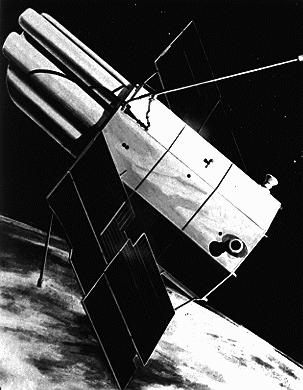 The Orbiting Astronomical Observatory (OAO), part of the physics and astronomy program, was established at NASA in 1959. Astronomers required stable orbiting platforms with telescopes to make observations in the infrared, optical, ultraviolet, and x-ray regions of the spectrum beyond earth's obscuring atmosphere. The Grumman-manufactured OAO spacecraft, basically a hollow cylindrical tube in which experiments were housed, could be precisely pointed with an accuracy of 1 minute of arc.
The Orbiting Astronomical Observatory (OAO), part of the physics and astronomy program, was established at NASA in 1959. Astronomers required stable orbiting platforms with telescopes to make observations in the infrared, optical, ultraviolet, and x-ray regions of the spectrum beyond earth's obscuring atmosphere. The Grumman-manufactured OAO spacecraft, basically a hollow cylindrical tube in which experiments were housed, could be precisely pointed with an accuracy of 1 minute of arc.
Two of the four planned OAO missions were launched in 1966 and 1968 with mixed results. OAO I suffered a battery malfunction and failed 1.5 hours into the mission. OAO 2 performed better than its designers had expected, returning useful data on the celestial sphere until February 1973. The third mission (OAO-B) failed when the protective nose cone failed to jettison during a launch attempt in 1970. The satellite never reached orbit. OAO 3, also called Copernicus, was highly successful, returning data from 1972 until 1980.
The experiments gathered for the unsuccessful OAO-B were called the Goddard Experiments Package, after rocket pioneer Robert Goddard. The investigators had planned to gather high-resolution spectral data from pointed and extended sources in the ultraviolet region of the spectrum. There were seven detectors in the Goddard package: six for ultraviolet and one for visible light. OAO-B's spectrophotometer was a 38-inch Cassegrain telescope with a Wright-Smith spectrometer; its spectral range was 1100-4267 Angstrom, with a resolution of 2A-8A-64A and a pointing accuracy requirement of 1 arc second.6
The highly successful OA0 3 returned data for eight years on the birth, death, and life cycles of stars. Its 450-kilogram Princeton Experiments Package contained a 32-inch telescope and spectrometer with a spectral range of 80-3000 Angstrom, a resolution of 0.1-0.5 Å, and a pointing accuracy requirement of 0.1 arc second. OAO 3 could view stars to the sixth magnitude. An x-ray experiment sponsored by University College of London studied stellar x-ray sources and x-ray absorption in interstellar space with three small telescopes.
The Orbiting Astronomical Observatory program was managed at NASA Headquarters by C. Dixon Ashworth. The Goddard Space Flight Center directed the project under the leadership of J. Purcell, OAO project manager, and J. R. Kupperian, Jr., OAO project scientist.
Manufacturer: Grumman
Power source: Solar arrays plus NiCd batteries
Length: 3.0 m
Width: 2.13 m, 6.4 m with solar panels extended
Shape: Octagonal cylinder with 2 solar panels
Launch vehicle: Atlas-Centaur
